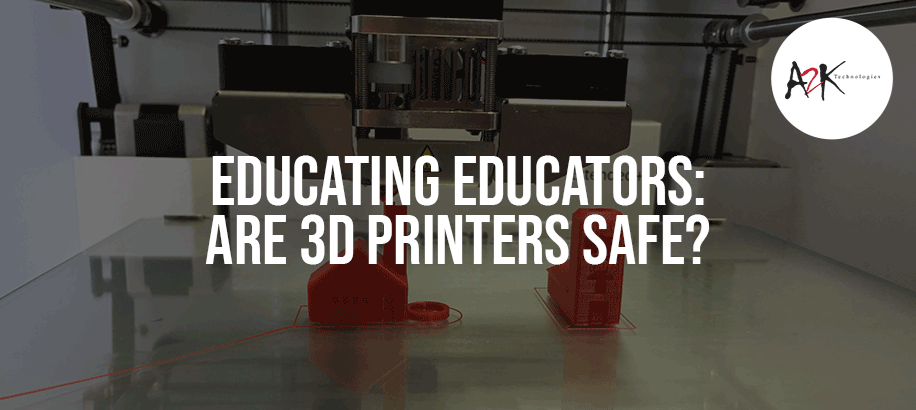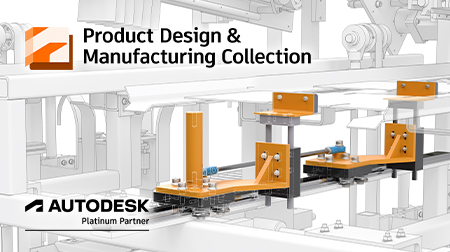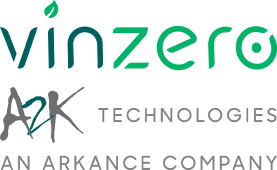
Educating Educators: Are 3D Printers safe?
By Debra Hynes l Redstack Civil, Infrastructure & Construction Specialist
3D printers are becoming increasingly popular as the technology improves and costs decrease. Today, 3D printers can be found everywhere - from research laboratories, primary schools, factories and people’s homes depending on their application. As 3D printers become more commonplace, it stands to reason that questions will be raised about user safety. There is very little research linking 3D printing to potential health issues, so it’s probably too early to tell what the potential long-term effects that exposure to 3D printers are likely to cause. It also stands to reason that if you only have a single 3D printer operating in your environment, it will have far less impact compared to a group of printers running at once.

See our range of filaments here: https://www.a2kstore.com/3d-printer-consumables
Risks and Filament Types
As with anything that has exposed working parts, runs on electricity or produces heat, there are risks of physical injuries from incorrect uses. This can be of particular concern to teachers who are often using them in the vicinity of children. The most common injuries associated with using 3D printers would be burns because fingers got too close to the extruder nozzles or the molten filament being forced through them. Generally speaking, as long as standard safety procedures are followed, the risk of injuries are small. But this does not consider the less obvious dangers such as emissions. All 3D printers produce VOP or Volatile Organic Particles during the printing process. VOPs are air-borne so the concern is inhalation, not contact or surface absorption. 3D printers can use many different types of filaments such as:
- PLA (PolyLactic Acid) - derived from corn starch.
- ABS (Acrylonitrile Butadiene Styrene) - a versatile petroleum-based material.
- TPU (Thermoplastic Polyurethane) - an extremely flexible Polyurethane based plastic.
Four common filaments: Acrylonitrile Butadiene Styrene (ABS), Polylactic Acid (PLA), Polyethylene Terephthalate (PET), and Nylon emit VOCs or Volatile Organic Compounds even at low temperatures. PLA plastic is shown to emit less VOCs and less odour compared to ABS plastic. ABS can also be more difficult to print with as it does not react well to even slight variances in temperature in the printing environment. This is why we generally recommend that schools use PLA filaments as they give off les VOCs, have an almost undetectable smell (unless you are hyper-sensitive to odours) and is more likely to result in a successful print outcome. There is some evidence that PLA-fed 3D printers are less harmful compared to ABS-fed 3D printers because of differences in emission rates, and because PLA is biocompatible. PLA is the most commonly used filament in the 3D printing industry. It prints easily, extrudes at 180°C (which is lower compared to other filaments) and has a wide variety of blends. These reasons make it a good option for beginners and professionals alike, but PLA is also biodegradable and nature-friendly under the right circumstances.
PLA is made up of small lactic acid units, which is an organic acid that plays an important role in our daily lives. Anything with glucose can be turned into lactic acid and the favourite source of glucose in this industry is corn. For PLA to biodegrade, the Polymer needs to be broken up by adding water, but it will still take time to degrade entirely. Fortunately, the particles given off by 3D printers are very small. All filaments including PLA may release toxic fumes when burnt known as VOCs (Volatile Organic Carbon). However, not all VOCs are toxic, although some may cause irritation especially for younger users. Printing in a large well-ventilated room is not generally a threat to the user. However, printing in a small poorly ventilated room may cause some issues due to the increased level of VOCs in the air. For those who would rather be safer than sorry - some 3D printers come with included filters or you can source after-market filtered covers. It is probably not necessary to restrict purchases to only units that include filters, because filters do not improve ease of use or quality of print.

Related items: https://www.a2kstore.com/ultimaker
HEPA vs Carbon - Which filter is better?
There are two main types of filters used in 3D printers - HEPA filters and Carbon filters but are they the same? HEPA filters remove VOPs and odour in the air whilst Carbon filters remove VOCs and odour in the air. HEPA is a standard for removing particles of .3um or greater, but it will not affect VOC fumes. Activated carbon charcoal filters remove VOCs emitted by 3D printing. Carbon filters are designed to trap much finer molecules that would pass right through a HEPA filter. In terms of 3D printing, it is unclear whether a HEPA or Carbon filter is more appropriate as both have their uses. What is clear is that either type of air filter is better than nothing and that a combination HEPA/Carbon filter is the best.
Conclusion
3D printer filaments can give off tiny particles that may be dangerous with constant long-term use. Laser printers also give off potentially dangerous particles and there have been no recommendations that all printers need to be fitted with a filter. If you spend extended periods near your 3D printer, you might end up with VOCs in your lungs. However, in many cases once the print starts, the user leaves the room since it can take hours for some prints to complete. This ‘start and return later process’ reduces the level of exposure to any particles. Generally, 3D printers pre-fitted with filtration systems are more expensive so users opt for lower-end models that are more difficult to use and produce inconsistent results. If you really want to be cautious, make sure the printer is in a ventilated area and that anyone working in the immediate vicinity wear a mask and safety glasses. The safety gear can easily be purchased from the local hardware store for a lot less than the cost of a filtration system.
Redstack only sells 3D Printers and 3D Printing products that we are prepared to use ourselves. Check out which educational 3D printer is best for you: https://www.a2kstore.com/education-solutions















